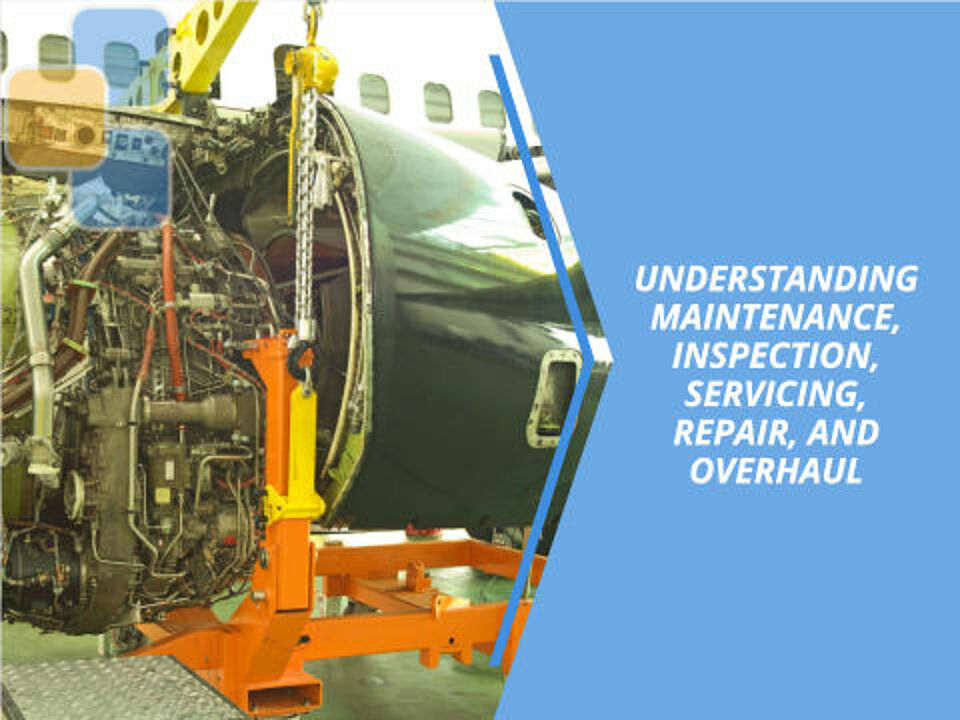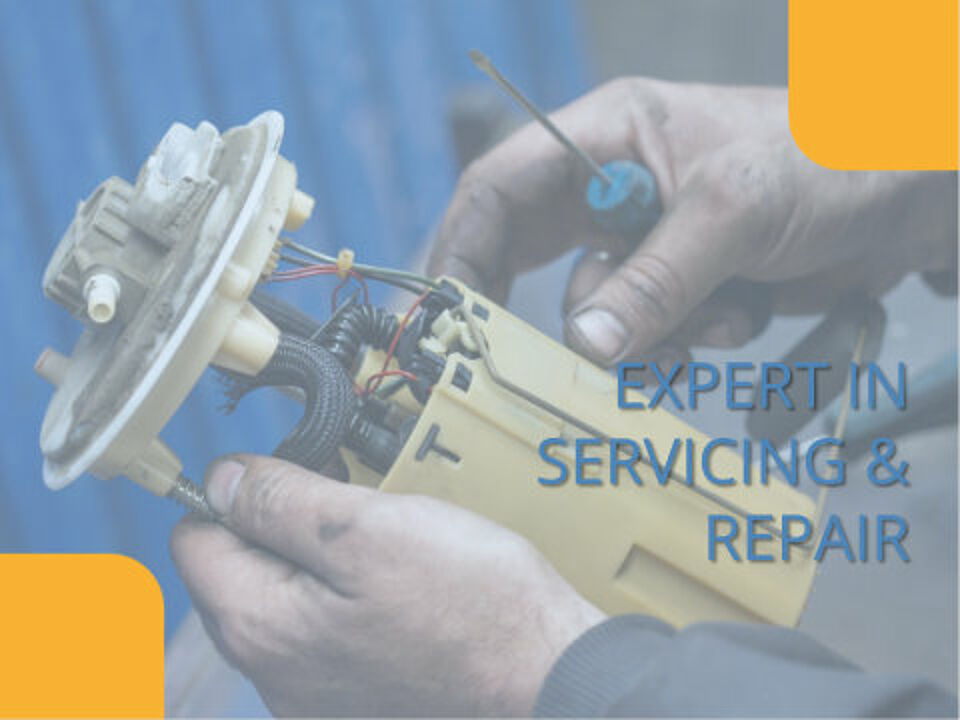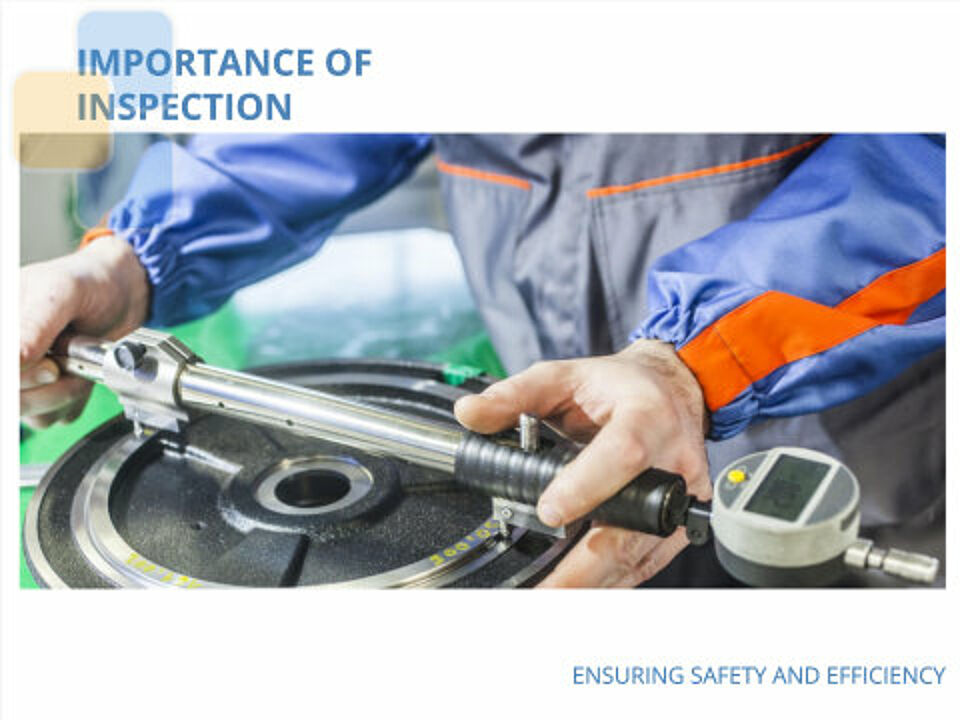
A system that does not run or does not run trouble-free costs money and reputation. To avoid this, service processes in the aftermarket must be managed in a structured, efficient, flexible and transparent manner. It doesn't matter whether it's scheduled maintenance or inspection or unplanned repairs and overhauls. A modular service management software enables the use of process-oriented workflows and thus makes an important contribution to achieving a high level of service excellence and customer satisfaction.
In the world of machines and systems, maintenance, servicing and inspection are crucial concepts that serve to maintain the functionality and extend the service life of these objects. However, there are clear distinctions between the terms and the specific fields of activity that ensure the smooth operation of machines and systems.

What is maintenance?
Maintenance refers to defined and regular measures that are carried out to ensure that a machine or system remains in a functional condition. Maintenance can have various objectives, including ensuring the actual condition, delaying the need for repairs and restoring the functional condition.
Definition of maintenance
Maintenance includes all measures aimed at keeping a machine or system in a functional condition for as long as possible. Both technical and administrative measures are taken into account to ensure regular operation and a functional condition.
Objectives of maintenance
The objectives of maintenance are to ensure the functionality of machines and systems, to delay the need for repairs and to restore the functional condition after wear, tear or defects.
Types of maintenance
There are five different types of maintenance, including modifying or corrective maintenance, regular or scheduled maintenance, condition-based maintenance, preventive maintenance and predictive maintenance.
- Modifying or corrective maintenance: This type of maintenance involves correcting faults and fixing problems that have arisen during operation. This is often referred to as reactive maintenance as it is carried out in response to an existing problem.
- Regular or scheduled maintenance: This type of maintenance follows a set schedule and includes routine inspections and maintenance to ensure that the appliance is working properly.
- Condition-based maintenance: This type of maintenance is based on the condition of the equipment. Sensors and measuring devices continuously monitor the condition of the equipment in order to take preventive action if deviations are detected.
- Preventive maintenance: In this type of maintenance, measures are taken to prevent potential problems before they occur. This can be based on experience or manufacturer specifications.
- Predictive maintenance: This type of maintenance uses advanced technologies such as data analytics and predictive modelling to predict when maintenance work needs to be carried out based on the actual condition of the equipment. This enables optimal use of resources and minimises downtime.

What is servicing?
The maintenance of machines / systems refers to the totality of all measures aimed at maintaining or restoring the functionality and value of this unit of consideration. It includes preventive maintenance as well as the repair of defects or damage.
Definition of servicing
In order to understand the difference between maintenance and inspection, it is first important to deal with the generic term for the activities that contribute to maintaining the functionality of a unit of observation (machines, systems, etc.). This process is referred to as maintenance in accordance with DIN 31051. It includes all measures to delay the need for repairs and to restore the functional condition of components, machines or systems.
Part of servicing
Maintenance includes regular servicing and the repair of defects in order to ensure the functionality of machines / systems and extend their service life.
An important part of maintenance is inspection, in which the condition of systems and machines is regularly checked in order to recognise and rectify potential problems at an early stage.
Another component is preventive maintenance, in which measures are taken to prevent wear and damage, such as the regular oiling and lubrication of moving parts.
Maintenance also includes the repair of defects, in which broken parts are repaired or replaced in order to restore the functionality of the systems.
In addition to these measures, it also includes documenting the work carried out and the condition of the systems in order to maintain an overview of the maintenance measures and create maintenance plans.
Overall, maintenance is therefore an important part of ensuring the reliability and efficiency of machines and systems and minimising downtime.
Preventive servicing
Preventive maintenance aims to maintain the functionality of machines / systems through regular inspections and minor repairs in order to avoid major damage or breakdowns.
Regular maintenance and inspections extend the service life of machines and systems and increase operational safety. In addition, potential defects can be recognised and rectified at an early stage before they lead to expensive downtime.
Preventive maintenance is based on a defined maintenance plan that specifies the respective maintenance intervals and measures. Wear parts are replaced in good time, lubricants are renewed and technical inspections are carried out.
What is the difference between servicing and overhaul?
The difference lies in their respective focus: overhaul is a part of servicing. While servicing aims to preserve the functionality of systems and machines, repair refers to the restoration of functionality after a failure or damage. Repair therefore includes repair and maintenance measures, whereas servicing includes preventive measures to avoid breakdowns and damage.
The aim of repair measures is to restore the proper functionality or the target condition of a system/machine. This includes, in particular, the replacement of damaged components that are not regarded as normal wear parts of a system. The term repair is often used synonymously.

What is inspection?
Inspection is the determination of the actual condition in connection with the functionality of machines / systems. Regular inspections enable defects and the causes of wear and tear to be recognised at an early stage in order to ensure functionality and safety. Worn components can be replaced promptly. The key is to understand why something is worn, which component, assembly or equipment is affected and what measures can be taken to prevent this by looking, measuring and testing.
Meaning and aim of the inspection
The aim of the inspection is to ensure the functionality of machines / systems by recognising and rectifying defects and wear at an early stage. This helps to extend the service life and minimises downtime.
Difference between maintenance and inspection
The difference between maintenance and inspection lies in the focus of the measures. Maintenance serves to ensure the actual condition and delay the need for repairs, while inspection is aimed at identifying defects and wear and tear.
DIN 31051 and inspection
DIN 31051 sets out clear requirements for inspection in order to ensure the functionality of machines / systems and to recognise and rectify defects at an early stage.
It defines the intervals and methods for inspections to ensure that the machines are operated in accordance with the manufacturer's specifications and that there is no danger to employees.
Inspections in accordance with DIN 31051 include regular visual inspections, checking operating parameters, functional testing of safety equipment and analysing operating data.
By complying with DIN 31051, companies can ensure the operational safety of their systems, increase productivity and minimise downtime. It also ensures that legal requirements and regulations are complied with.

Repair and overhaul
Repair and overhaul are important measures to ensure the functionality of machines / systems or buildings. However, there are clear differences between these two fields of activity that are relevant to taking the right measures to restore functionality.
Difference between repair and overhaul
The difference between repair and maintenance lies in the restoration of functionality.
Repair refers to the short-term elimination of a specific problem or defect in order to restore functionality. This can be, for example, the replacement of a defective part or the repair of damage.
Overhaul, on the other hand, is a more comprehensive measure aimed at restoring the overall functionality and value of a machine or system. Preventive measures are often also taken to avoid further damage.
Another difference lies in the duration and scope of the measures. Repairs are often short-term measures that specifically target a problem. Overhauls, on the other hand, may require a longer time frame and more detailed planning to restore overall functionality.
To summarise, repair is the elimination of a specific defect, while overhaul aims to restore the overall functionality and value of a machine or system.
Measures to delay the need for repairs
There are various measures that contribute to delaying the need for repairs, including regular maintenance, preventive maintenance and the timely detection of defects through inspections.
Functionality after repair
After a successful repair or overhaul, it is crucial to check the functionality of the machines / systems to ensure that they meet the requirements and are ready for operation again.
Various tests and inspections can be carried out to ensure that all components are working properly and that the performance of the machinery/equipment meets the standards. This can be done, for example, through load tests, functional tests or performance measurements.
It is important that the functionality is thoroughly checked in order to recognise and rectify potential problems or defects at an early stage. A thorough check can ensure the safety of the system and employees and prevent breakdowns or production interruptions.
After the repair, it is advisable to carry out regular maintenance and inspection work to ensure the long-term functionality of the machines / systems and to recognise potential problems at an early stage.

How are maintenance and servicing connected?
The link between maintenance and servicing is crucial to ensure the functionality and service life of machines and systems. Preventive maintenance and servicing as well as the maintenance of wearing parts play a key role in this.
Preventive maintenance and servicing
The aim of preventive maintenance and servicing is to maintain the functionality and value of machines and systems through regular maintenance and inspections and to prevent major damage or breakdowns.
Maintenance and inspection
The combination of maintenance and inspection is crucial to ensure the functionality of machines and systems. Maintenance is aimed at ensuring the actual condition, while inspections recognise and rectify defects and wear at an early stage.
Maintenance of wearing parts
The maintenance of wearing parts is an important part of ensuring the functionality of machines and systems. Regular maintenance allows wear parts to be identified and replaced in good time in order to minimise downtime.
Definition: Aftermarket
Durable consumer goods such as automobiles or capital goods such as machinery and equipment offer manufacturers opportunities for additional sales and stronger customer loyalty in the so-called aftermarket. The aftermarket includes all goods and services that are delivered or provided after the original purchase of a primary object.
Examples include maintenance and repair services, the distribution of spare parts and operating materials or accessories. The aftermarket thus represents an additional source of revenue for companies - and without the competitive pressure that prevails on the primary market. In addition, the aftermarket offers the opportunity to increase customer loyalty and retention by inspiring your customers with outstanding, efficient service.
"A company devoted unreservedly to service has only one concern about profits: they are embarrassingly large." Henry Ford
What support does service management software offer for the aftermarket?
An SMS as a central service platform should be open, flexibly adaptable and process-oriented. The requirements of all service areas in a company are mapped centrally in this platform - regardless of whether it is a matter of planned maintenance or inspection or a repair and overhaul required at short notice.
Evaluation from different perspectives
The evaluation of the services provided, the time, financial and human resources and materials used ensures transparency. This is possible at the push of a button and is supported by predefined, immediately usable standard reports. The data can be evaluated from different perspectives (e.g. process owner, customer, external service provider) and time dimensions. To ensure that the experience gained is not lost, it is advisable to maintain a successively growing service database for the company. In this way, resource control and knowledge management can be continuously optimised.
Workflow concept
A consistent workflow concept ensures that you can plan, organise and control processes in the aftermarket not in isolation, but as an overall business performance. In this way, you adopt the same perspective as the customer, for whom it is primarily important that the service functions quickly and in a targeted manner when a repair order is placed - and not how it is organised in the background. In addition, there are sensible automations with which you accelerate and secure process standards (e.g. ticket creation, delegation and tracking, reporting).
This is how First Level Support benefits
When your customer has a problem with a machine, system or service and therefore contacts First Level Support, they want help quickly above all. With a ticket system, the caller can be identified directly. For this purpose, all customer-relevant information is displayed to the support staff and combined in a customer-specific process. It does not matter whether the request is received by telephone, chat, e-mail, portal or network.
Preconfigured checklists enable the first level support to quickly record and structure the message. If the customer's enquiry cannot be answered without support, the employee can transmit the relevant details on faults and failures in digital form to internal or external service providers. In this way, processing can be continued without delay.
Optimal support for field service and field staff
Field service staff are perceived by the customer as representatives of your company. With a service management system, you ensure that they always have all the information they need to deal with the issue quickly and efficiently. Enquiries with the head office or colleagues in the warehouse, production or other areas are possible in real time via the system, as is the provision of files and documents. And the field service staff can also access the central knowledge database directly and add to it, so that all learning is permanently available to the company.
Efficient and transparent processes
The central system is accessed via a mobile device. In this way, the work report is already created automatically during the activities on site, and time and material consumption are documented precisely and without manual entries. This not only saves the field service staff a lot of time, but also prevents multiple entries or gaps in the documentation.
The customer already receives the digital service report with a handshake and the feedback to the head office takes place even before the employee is back in the company or on the way to the next customer. The subsequent recording of protocols and reports is no longer necessary, as these are directly recorded and aggregated in the service process.
Invoice generation is just as quick and easy: The basis is the mobile recorded services, times and work resources, which can be evaluated and aggregated according to any time period (e.g. assignment, month, quarter, etc.) for the purpose of invoicing. This not only means considerably shorter processing times in the field, but also significantly better evaluability and optimisability of service processes, which of course can also be condensed across locations or customers.
Another benefit: for each supplier, a complete history of the service life, intensity of use, etc. of their parts can be generated at the push of a button. This makes it possible to conduct fact-based negotiations and target discussions and increases transparency on both sides.
Service Management with EcholoN
The holistic service management software EcholoN has a modular structure and can be scaled as required. It has a basic architecture with open interfaces, integrated web services and simple adaptability. All relevant functional areas are mapped completely integrated in the system. This enables comprehensive reporting and use "out-of-the-box", i.e. without customisation.
What distinguishes EcholoN from other solution providers is a high degree of flexibility: different editions (Express, Standard, Professional and Enterprise) provide the appropriate functions and process schemes for every area of use and application. This means that SMEs benefit just as much as international corporations that want to offer their customers customised service and aftermarket services.
They can use EcholoN both for their own services and to integrate external service providers. Service, repair, maintenance or servicing orders can be recorded, tracked, evaluated and invoiced in the system - so operations can be better planned and response times shortened. All processes in the aftermarket - from regular maintenance to unplanned repairs - are documented centrally and are thus completely transparent.
Maybe also interesting:
- Blog article: CMMS - Computerised Maintenance Management System
- Blog article: Field Service Management
- Blog article: Customer service
- Blog article: Computer Aided Facility Management - CAFM
